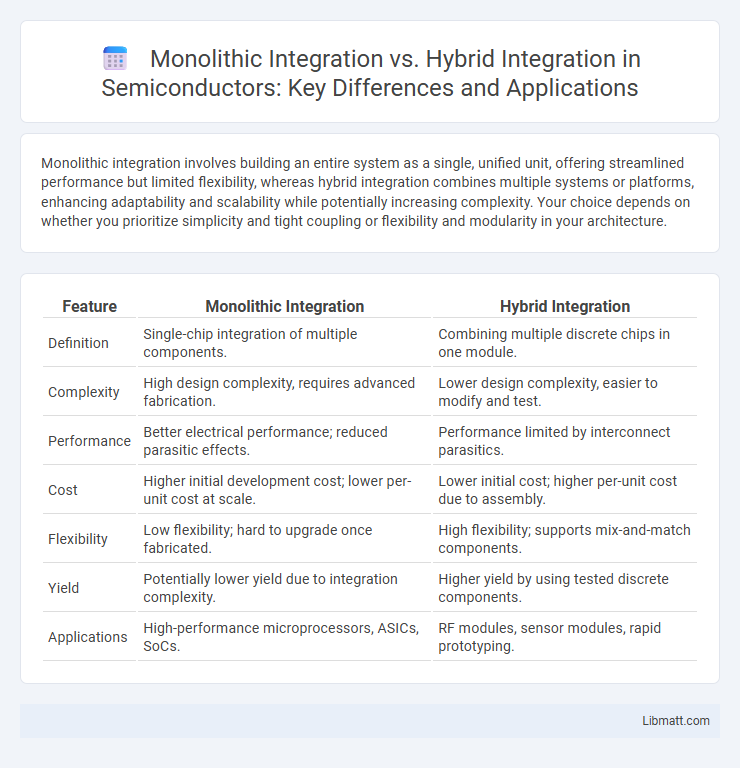Monolithic integration involves building an entire system as a single, unified unit, offering streamlined performance but limited flexibility, whereas hybrid integration combines multiple systems or platforms, enhancing adaptability and scalability while potentially increasing complexity. Your choice depends on whether you prioritize simplicity and tight coupling or flexibility and modularity in your architecture.
Table of Comparison
| Feature | Monolithic Integration | Hybrid Integration |
|---|---|---|
| Definition | Single-chip integration of multiple components. | Combining multiple discrete chips in one module. |
| Complexity | High design complexity, requires advanced fabrication. | Lower design complexity, easier to modify and test. |
| Performance | Better electrical performance; reduced parasitic effects. | Performance limited by interconnect parasitics. |
| Cost | Higher initial development cost; lower per-unit cost at scale. | Lower initial cost; higher per-unit cost due to assembly. |
| Flexibility | Low flexibility; hard to upgrade once fabricated. | High flexibility; supports mix-and-match components. |
| Yield | Potentially lower yield due to integration complexity. | Higher yield by using tested discrete components. |
| Applications | High-performance microprocessors, ASICs, SoCs. | RF modules, sensor modules, rapid prototyping. |
Introduction to Integration Techniques
Monolithic integration involves combining all system components into a single, unified architecture, ensuring streamlined communication and reduced latency. Hybrid integration merges monolithic and microservices architectures, enabling flexibility by leveraging the benefits of both centralized control and distributed services. Choosing between these techniques depends on scalability requirements, system complexity, and development agility.
Defining Monolithic Integration
Monolithic integration refers to a unified system architecture where all components and functionalities are built and deployed as a single, cohesive unit, ensuring tight coupling and direct communication within the application. This approach simplifies deployment and can improve performance due to reduced latency between modules but may limit scalability and flexibility compared to hybrid integration models. Monolithic systems often face challenges in adapting to changes or incorporating diverse technologies without significant redesign.
Defining Hybrid Integration
Hybrid integration combines multiple integration methods, such as on-premises systems and cloud services, to create a flexible IT environment. It enables seamless data exchange and application interoperability across diverse platforms, optimizing business workflows. This approach contrasts with monolithic integration, which relies on a single, unified system architecture.
Key Differences Between Monolithic and Hybrid Integration
Monolithic integration involves a single, unified system where all components are interconnected and managed as one, leading to simplified deployment but limited flexibility and scalability. Hybrid integration combines on-premises and cloud-based systems, enabling greater adaptability, improved data interoperability, and seamless communication across diverse platforms. Key differences include monolithic's rigid architecture versus hybrid's modular approach, with hybrid integration supporting faster innovation and easier maintenance in complex IT environments.
Performance Comparison: Speed, Efficiency, and Scalability
Monolithic integration offers superior performance with faster data processing and lower latency due to its unified architecture, making it highly efficient for tightly coupled systems. Hybrid integration provides greater scalability and flexibility by combining multiple platforms and technologies, enabling your infrastructure to adapt and grow without significant performance degradation. Choosing between them depends on your need for speed and efficiency versus scalability and diverse integration capabilities.
Cost Analysis: Development and Production
Monolithic integration typically incurs higher development costs due to the complexity of building a single cohesive system, but benefits from streamlined production processes that can reduce long-term manufacturing expenses. Hybrid integration often requires more upfront investment in designing compatible interfaces and managing multiple components, yet it allows for flexible upgrades and potentially lowers initial production costs through modular assembly. Your choice between these approaches should consider the balance between upfront development expenses and long-term production efficiency to optimize overall project cost-effectiveness.
Application Areas and Use Cases
Monolithic integration is predominantly used in tightly coupled systems where performance and low latency are crucial, such as embedded systems, aerospace controls, and real-time processing applications. Hybrid integration excels in complex, multi-component environments like telecommunications, automotive systems, and IoT platforms, where interoperability between diverse technologies and scalability are essential. Use cases for monolithic integration emphasize streamlined hardware-software synergy, whereas hybrid integration facilitates modularity and flexible upgrades across heterogeneous systems.
Design and Manufacturing Challenges
Monolithic integration presents design and manufacturing challenges such as increased complexity in process control, limited material diversity, and higher defect rates due to the integration of multiple functions on a single substrate. Hybrid integration offers greater flexibility by combining separately optimized components, but faces difficulties in alignment precision, interconnection reliability, and packaging complexity. Both approaches demand advanced fabrication techniques to balance performance, yield, and scalability in high-density electronic systems.
Future Trends in Integration Technologies
Future trends in integration technologies emphasize a shift towards hybrid integration platforms that combine the scalability and central control of monolithic systems with the flexibility and agility of cloud-native microservices. Advances in AI-driven automation and API management enhance seamless connectivity across diverse environments, optimizing performance and reducing integration complexities. Your business can leverage these hybrid solutions to adapt quickly to evolving technological demands and ensure long-term scalability.
Choosing the Right Integration Approach
Choosing the right integration approach depends on your organization's specific needs, scalability requirements, and system complexity. Monolithic integration offers a unified, tightly-coupled architecture ideal for simpler, stable environments, while hybrid integration combines multiple methods and platforms to support diverse applications and evolving technologies. Your decision should prioritize flexibility, maintainability, and the ability to integrate legacy systems alongside modern cloud services.
Monolithic Integration vs Hybrid Integration Infographic

 libmatt.com
libmatt.com